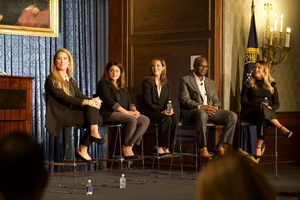The Secret to Building Loyalty in the Hourly Workforce
In a deskless economy lies the challenge of employee retention: QSR Magazine revealed that only 54% of quick service employees completed 90 days before quitting in 2022. With high turnover and increasing financial losses, companies want answers and solutions, especially because training and onboarding can cost up to $5,000 per worker. After surveying hourly workers throughout workforce culture shifts, companies confront assumptions about their motivations.The issue is not that people want to stop working for companies. According to Daniel Blaser, head of brand at Workstream, the problem is the opposite. “You don't want to feel like you're working at a dead-end job,” Blaser said. “That's why for a lot of those in the hourly workforce, there has been really high turnover rates.”This key finding was one of the focal points discussed during Workstream’s recent From Day One webinar. Blaser discussed eight key ways to foster loyalty and engagement with hourly workers. Then, he revealed two lesser-known but equally crucial factors contributing to employee retention. Attract Employees Looking For StabilityA McKinsey & Company study found that 41% of workers reported quitting their previous jobs due to lower career development and advancement opportunities. The study also found that 31% quit because of a lack of meaningful work. Blaser says this is a result of the miscommunication of advancement opportunities.Companies should discuss what opportunities are available as early as the job description. Blaser used the following scenario. “‘This role has the potential to transition into this role within six months.’ Something like that provides a concrete example that this opportunity can lead to other opportunities, and you’re looking for someone long-term and not just to fill a vacancy for a couple of months.”Daniel Blaser of Workstream led the From Day One webinar (company photo)Optimize Onboarding and Orientation ProcessesBlaser offered some onboarding tips, such as making new hire paperwork easy to complete by transitioning to digital to save time and resources and including company culture training during orientation to make workers feel integrated sooner. Lastly, he encourages organizations to assign new hires a mentor to learn from during the first few weeks.Workstream provides a text-based HR management platform to ease the completion of paperwork. This simple and progressive approach to documentation optimizes onboarding. Companies can focus more on developing dynamic and engaging onboarding and training programs.Provide Valuable BenefitsMore valuable benefits keep people coming back to work, offer benefits like paid time off, family care, career development, retirement plans, and health insurance. Companies can also use creativity to create benefits. Blaser advised quick-service restaurants to offer workers two meals for completing 8-hour shifts.Offer More Competitive WagesWorkers leave their positions and seek others with more competitive wages. Workstream has a free hourly wage index to reference. Companies can benchmark pay across industries and see where they compare and contrast.Invest in Career DevelopmentHourly workers are looking for careers, not temporary jobs. To address advancement expectations, Blaser advised the following. “I'd say frequency is more important than scope. It's better to have more opportunities more frequently, then dangle some big, you know, two-year advancement for two straight years, but have nothing else in the middle.”Employee RecognitionAccording to a Nectar survey of 800 full-time employees, 83.6% of employees say recognition affects their motivation to succeed at work. 81.9% agreed it contributes to their engagement with their job. Blaser notes that weekly formal and informal recognition garners better results.Train Your ManagersWith a smaller scope of talent, companies may choose managers based on availability. This process can be detrimental without proper and ongoing leadership training. “People don’t quit jobs, they quit managers,” he cautioned.Be Open to Exchanging FeedbackExchanging feedback makes your company a better place to work and it gives employees a voice and helps them feel valuable and integrated into the company.Other Opportunities for Higher Employee RetentionBlaser revealed two surprising factors most companies overlook. These significantly contribute to higher hourly employee retention, sometimes more than competitive wages.First, flexibility is essential. Hourly workers have shown a preference for flexibility over competitive wages. Employees value reasonable accommodations in emergencies.Second, employees value autonomy. Workers look for trust to make decisions on behalf of their companies when demonstrating their capabilities.Your Company Culture: The Deciding FactorThese eight key ways and lesser-known opportunities build loyalty among hourly workers. By exploring these opportunities, companies can create an engaging company culture that encourages retention.A thriving company culture is a culmination of internal investment, adaptability, and stability. The goal is to create a sustainable, promising, and supportive work environment. Hourly workers are searching for these kinds of jobs, Blaser says.“Being able to have a culture where employees feel valued, they feel connected to their coworkers, and they feel like they are contributing to kind of a greater whole – all those things are really important.”Editor's note: From Day One thanks our partner, Workstream, for sponsoring this webinar. Stephanie Reed is a freelance news, marketing, and content writer. Much of her work features small business owners throughout diverse industries. She is passionate about promoting small, ethical, and eco-conscious businesses.





















